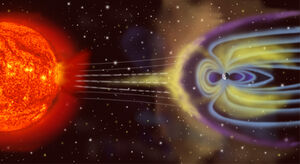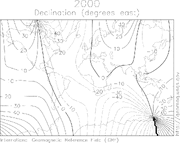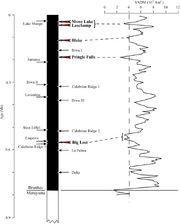Assessment |
Biopsychology |
Comparative |
Cognitive |
Developmental |
Language |
Individual differences |
Personality |
Philosophy |
Social |
Methods |
Statistics |
Clinical |
Educational |
Industrial |
Professional items |
World psychology |
Biological: Behavioural genetics · Evolutionary psychology · Neuroanatomy · Neurochemistry · Neuroendocrinology · Neuroscience · Psychoneuroimmunology · Physiological Psychology · Psychopharmacology (Index, Outline)

The magnetosphere shields the surface of the Earth from the charged particles of the solar wind. It is compressed on the day (Sun) side due to the force of the arriving particles, and extended on the night side.
Geomagnetism arises from the Earth's magnetic field (and the surface magnetic field) is approximately a magnetic dipole, with one magnetic pole near the north pole and the other near the geographic south pole. An imaginary line joining the magnetic poles would be inclined by approximately 11.3° from the planet's axis of rotation. The cause of the field is probably explained by dynamo theory. The magnetic field extends several tens of thousands of kilometres into space as the magnetosphere.
Magnetic poles[]

Magnetic declination from true north in 2000.
The locations of the magnetic poles are not static but wander as much as 15km every year (Dr. David P. Stern, emeritus Goddard Space Flight Center, NASA). The pole position is usually not that indicated on many charts and many magnetic pole marking brings a confusion as to what is being located at the given positions. The Geomagnetic Pole positions are usually not close to the position that commercial cartographers place "Magnetic Poles." "Geomagnetic Dipole Poles", "IGRF Model Dip Poles", and "Magnetic Dip Poles" are variously used to denote the magnetic poles. [1]
The Earth's field is changing in size and position. The two poles wander independently of each other and are not at directly opposite positions on the globe. Currently the south magnetic pole is farther from the geographic south pole than the north magnetic pole is from the north geographic pole.
Field characteristics[]
The field is similar to that of a bar magnet, but this similarity is superficial. The magnetic field of a bar magnet, or any other type of permanent magnet, is created by the coordinated motions of electrons (negatively charged particles) within iron atoms. The Earth's core, however, is hotter than 1043 kelvin, the Curie point temperature at which the orientations of electron orbits within iron become randomized. Such randomization tends to cause the substance to lose its magnetic field. Therefore the Earth's magnetic field is caused not by magnetised iron deposits, but mostly by electric currents in the liquid outer core.
Another feature that distinguishes the Earth magnetically from a bar magnet is its magnetosphere. At large distances from the planet, this dominates the surface magnetic field. Electric currents induced in the ionosphere also generate magnetic fields. Such a field is always generated near where the atmosphere is closest to the Sun, causing daily alterations which can deflect surface magnetic fields by as much as one degree.
Magnetic field variations[]

Geomagnetic variations since last reversal.
The strength of the field at the Earth's surface ranges from less than 30 microteslas (0.3 gauss) in an area including most of South America and South Africa to over 60 microteslas (0.6 gauss) around the magnetic poles in northern Canada and south of Australia, and in part of Siberia.
Magnetometers detect minute deviations in the Earth's magnetic field caused by iron artifacts, kilns, some types of stone structures, and even ditches and middens in geophysical survey. Using the magnetic instruments adapted from airborne devices developed during World War II to detect submarines, the magnetic variations across the ocean floor have been mapped. The basalt -- the iron-rich, volcanic rock making up the ocean floor -- contains a strongly magnetic mineral (magnetite) and can locally distort compass readings. The distortion was recognized by Icelandic mariners as early as the late 18th century. More important, because the presence of magnetite gives the basalt measurable magnetic properties, these magnetic variations have provided another means to study the deep ocean floor. When newly formed rock cools, such magnetic materials record the Earth's magnetic field.
Magnetic field decay[]
The earth's magnetic field strength was measured by Carl Friedrich Gauss in 1835 and has been repeatedly measured since then, showing an exponential decay with a half-life of about 1400 years. This could also be stated as a relative decay of about 10% to 15% over the last 150 years.
References[]
See also[]
External links[]
- "The Great Magnet, the Earth" A history of geomagnetism (20+ sections), marking the 400th anniversary of "De Magnete" by William Gilbert (reviewed). Also covers early magnetic surveys, dynamo theory, the Sun's magnetic effects, geomagnetic reversals, and magnetospheres of Earth and planets. With timeline, glossary, historical review article (cited below), Q&As and translations to Spanish, German and French.
- USGS Geomagnetism Program. Real time monitoring of the Earth's magnetic field. U.S. Department of the Interior, U.S. Geological Survey, February 17, 2005.
- Geomagnetism. National Geophysical Data Center, NOAA. Apr-2005.
- BGS Geomagnetism. Information on monitoring and modelling the geomagnetic field. British Geological Survey, August 2005.
- A Millennium of Geomagnetism, a history of geomagnetism, with many scientific references.
- William J. Broad, "Will Compasses Point South?". New York Times, July 13, 2004.
- John Roach, "Why Does Earth's Magnetic Field Flip?". National Geographic, September 27, 2004.
- "Magnetic Storm". PBS NOVA, 2003. (ed. about pole reversals)
- "When North Goes South". Projects in Scientific Computing, 1996.
ar:مغنطيسية أرضية de:Erdmagnetfeld es:Campo magnético terrestre fr:Champ magnétique terrestre gl:Campo magnético terrestre nl:Aardmagnetisch veld pt:Campo magnético terrestre fi:Maan magneettikenttä zh:地磁场
- ↑ "Problem with the "MAGNETIC" Pole Locations on Global Charts". Eos Vol. 77, No. 36, American Geophysical Union, 1996.